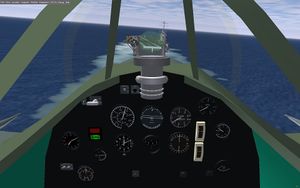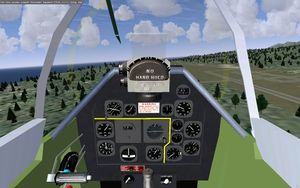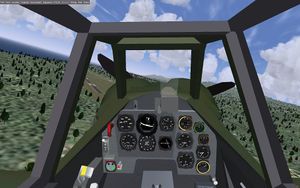Flying warbirds
| Work in progress This article or section will be worked on in the upcoming hours or days. See history for the latest developments. |
WWII fighter aircraft (also known as 'warbirds') are fun to fly because they are very maneuverable and fast, yet challenging due to how they operate differently from modern aircraft. This article applies to warbirds as single-engine propeller driven fighter aircraft with a tailwheel. As far as FlightGear models are concerned, this includes the P-51D, the A6M2, the Spitfire IIa, the Seafire IIIc, the Bf-109 G15 or the Fw-190 A8, but for example not other WWII warplanes like the Me-262 (as a jet fighter craft), the B-17 Flying Fortress (a four-engine bomber) or the P-38 Lightning (a two engine aircraft).
The main difficulties in flying warbirds come from the following characteristics:
- They have a single, very powerful engine.
- They accelerate and decelerate on the runway with the tail low and the aircraft nose high.
- They need to be operated for very different airspeeds.
Takeoff
Differences from modern aircraft
Attempting to use standard takeoff procedures from that of a modern aircraft with a warbird will usually end in disaster. The typical process of releasing the brakes, increasing the throttle to full, and waiting for the aircraft to reach its takeoff speed, can result in the tail of the aircraft lifting (causing the nose to point down such that the runway becomes visible). Moments later, the aircraft will begin to turn wildly and lose control, typically leaving the runway and crashing.
The reason this happens is a combination of aerodynamic effects occuring for single propeller driven aircraft known as propeller wash, torque and P-factor (details can be found in the article Understanding Propeller Torque and P-Factor). Basically, as soon as the tail lifts, the tail is pushed to the side by the propeller wash, and as soon as the aircraft lifts off the ground, it has a tendency to roll due to torque. That makes takeoff with a warbird a bit tricky, mildly put.
Takeoff methods
There are two basic strategies for takeoff given these problems, and which one works better depends on the plane. Note also that regardless of how you take off, warbirds usually do not require full throttle, and less power also means less torque and less wash. The first strategy is to counter the propeller wash by the rudder action. This requires fast and precise rudder and aileron movements.
Anticipate aircraft motion
For this, you need to be able to control rudder independent of ailerons. For example, if you use mouse as input device, you would usually employ --enable-auto-coordination as an option which moves the rudder in combination with the ailerons, which is precisely what is needed during normal flight conditions. It is however possible to control the rudder directly by moving the mouse left and right while holding the left mouse button, and that is needed here. Keyboard control would be another possibility, but is likely not fast and accurate enough. A joystick and rudder pedals as in a real plane are obviously best, but it is possible to get warbirds airborne with the mouse alone, although not always in the most elegant way.
The idea is to anticipate the motion of the aircraft: As soon as the tailwheel lifts, step on the rudder with a measured motion to counter the sideward swing of the tail. This takes some practice. If done right, the aircraft continues along the runway with the tail up, and you can accelerate a bit further before gently pulling on the stick (otherwise you bang the tail back into the runway) to take off. As soon as the front wheels lift, torque will lead to a tendency to roll, but once in the air this can be countered with the ailerons, and even with mouse and auto-coordination on, dealing with the roll will just displace you a bit from the runway which is easily corrected.
The most severe problem is that the aircraft may turn sideways and then start to roll with one front wheel still on the ground. Typically the roll indicates that you waited too long to pull up (if the aircraft can lift one front wheel and roll around the other, it can also lift both). This cannot be countered with mouse and auto-coordination on, as it requires independent rudder and aileron control at the same time. For planes which do this, a different takeoff strategy often works.
There has been anecdotal success with this method for some of the following aircraft:
- P-51D
- Fw-190 AB
- A6M2
Keep tailwheel down
The second strategy is to keep the tailwheel down as long as possible, because as long as it is on the ground, the tail cannot swing to the side, and the faster the aircraft moves, the milder is the effect of propeller wash. For this, you need to pull back gently on the stick while still on the runway, the elevator then pushes the tail down. Do not pull the stick all the way back, though, otherwise you'll lift into very unstable flight. If you start with extended flaps, the aircraft may even directly lift off from all three wheels at once, which makes for a comparatively quiet takeoff. As above, torque is countered easily when in the air. Since liftoff occurs in an aerodynamically unstable situation (essentially close to stall with high AOA) you need more throttle than with the first strategy to accelerate quickly into stable flight after liftoff. Once you gained some altitude, push the nose a bit down to get into aerodynamically favourable conditions before climbing out.
There has been anecdotal success with this method for some of the following aircraft:
- Spitfire IIa
- Seafire IIIc
- Bf-109 G14
Controlling variable pitch propellers
Typically WWII aircraft are equipped with variable pitch propellers, for some of them, e.g. the P-51D, the Spitfire IIa or the Seafire IIIc, the pilot controls the propeller pitch, others like the Fw-190 A8 or the Bf-109 G14 have an automatic pitch control that takes over at some point, but under certain conditions the pilot must still control the pitch. In practice, this means that simply increasing or decreasing the throttle (PgUp/PgDn) will not usually adjust thrust as it does on other aircraft. Rather, the thrust acting on the aircraft is determined by a combination of the throttle setting and propeller pitch setting (which can be adjusted using n and ⇧ Shift+N, or sometimes via the pitch lever, found next to the throttle on the left side of the cockpit).
The underlying reason is twofold: First, the thrust generated by the propeller depends on its rate of air displacement. This means that the same amount of thrust can be generated by a propeller which displaces a lot of air with each turn, but rotates slowly and a second propeller which displaces half the amount of air per turn, but rotates with twice the speed. The pitch setting is the angle at which the propeller blades are placed and hence controls the air displacement per rotation. A shallow angle corresponds to a small displacement per turn, whereas a large angle affects a larger air volume. However, in essence a propeller blade is nothing but a wing, and like an aircraft wing, it has an optimum angle of attack. If the airstream meets the propeller blades at this angle, the propeller generates thrust with maximum efficiency, at any other angle the propeller does not perform optimal. As a consequence, the optimal pitch setting for an aircraft accelerating on the runway at speeds below 100 kt is different from the optimal setting for the cruise speed of 350 kt, as the airstream at the propeller blades is given by a combination of the propeller's rotating motion and the motion of the aircraft in the air.
It is possible to construct propellers which adjust the pitch according to the airspeed - but that neglects the more important second issue: the engine. What the throttle controls is the internal power consumption of the engine. The relevant gauge is manifold pressure (in German aircraft measured in ata, in English in PSI, in US aircraft in inHG). Manifold pressure is a measure for the force acting inside the engine, and this force increases when throttle is increased. However, this is not the power output of the engine. This quantity depends on the efficiency of the engine, and piston-engine efficiencies depend crucially on the rotation speed (rpm). They have maximum efficiency only in a narrow band (for the P-51D for example between 2500 and 3000 rpm), outside this window, the engine efficiency decreases drastically. This means that with such an engine, one can not simply trade a shallow propeller pitch angle and small air displacement per turn against a faster rotation speed. Rather, the pitch angle at fixed throttle setting must be chosen such that the engine runs at optimum RPM. Propellers which perform this automatically are called constant speed propellers.
This can be observed in level flight by leaving the thottle at a given setting. Increasing the angle between blade an airstream means more air displacement per turn, i.e. the propeller has do more work against air resistance, and hence the engine rpm drop. Decreasing the angle on the other hand reduces the drag on the propeller per turn, and hence the engine can spin up to higher rpm.
For flying the aircraft, this means that in a given flight situation, you first adjust the throttle to the desired thrust setting and monitor manifold pressure (for example, in the P-51D you should not exceed 61 inHg needlessly) and then adjust the pitch such that the engine rpm is in the optimum region. For each aircraft, you have to know both the operating manifold pressure and the optimum rpm.
For takeoff, as the aircraft is initially at rest, the optimum angle is rather shallow (see setting from aircraft help, or set angle to minimum using (n) till the pitch lever has reached its most forward position). For landing, one often wants to render the propeller effectively inefficient, so one can increase the angle to its maximum value (using ⇧ Shift+n). This is followed by an audible spin-down of the engine to low rpm.
Fast and slow flight mode
It can be useful to think of a warbird having a fast and a slow flight mode (although in reality there is no corresponding sharp distinction). In the slow flight mode, the aircraft nose in level flight points above the horizon. In fact, the cockpit view is similar to the view from the aircraft when it is standing on the runway (i.e. the runway in front of the pilot is not visible through the cockpit glass). In the fast flight mode, the aircraft nose points towards the horizon and the view is much better. The difference between the two modes is of course the angle of attack (AOA, the angle at which the airstream hits the wing), and this corresponds to a different ratio between drag and lift.
A transition between the modes must take place after takeoff and before landing, and it is useful to mentally make the transition. You'll notice for example that after takeoff, retracting gear and flaps the plane may be very slow in building speed, even with throttle set to full. This happens when the pilot never leaves slow flight mode. It is then necessary to push the nose down to the horizon level. The plane responds by losing some altitude, but starts accelerating rapidly as drag is reduced and soon goes back to climbing much faster than before.
Similarly, to slow the plane down before landing, it is not sufficient to put the engine to idle, extend flaps and lower gear. Rather, the pilot must pull the aircraft nose up, let the plane climb to lose airspeed, and then descend with nose raised when the slow flight mode is reached.
It is very difficult to achieve a change of flight mode without a modification in altitude, thus it's much more convenient to take the altitude change into account and plan takeoff and landing accordingly.
Landing
Landing warbirds is as tricky as getting them into the air. The problems fall into two different groups: Getting the plane to the desired spot on the runway, and decelerating the plane.
The first problem is that some planes (most notably the P-51D) don't descend well - even with throttle in idle, gear lowered and flaps extended they glide very well and just gain speed when one tries to lower altitude. At times, one seriously wishes for speedbrakes or a braking chute. Some people suggest switching off the engine - but I wouldn't do that in case you miss the approach. The correct solution would be a forward slip (moving rudder and ailerons against each other) - but if you're flying with auto-coordination, that can't be done. Thus, in order to descend to land, one has to fly them into slow flight mode close to stall speed - then they descend without gaining speed, but one may still need a very flat approach. If you (like myself) enjoy flying in the mountains, there may not be space for a long shallow approach - so then you need to spiral down by flying circles in slow flight mode till you reach the correct altitude for final approach.
Flying in slow flight mode has its own problems - in a straight approach, one can't see the runway because the aircraft nose is in the way. This can be solved by approaching at an angle or from a shallow curve - then the runway is always visible during approach - and only aligning the aircraft with the runway in the last possible moment.
Thus, the approach with warbirds almost always requires turns in slow flight - however, the aerodynamics in a turn is different from straight flight, the aircraft descends more rapidly, and you must be ready to compensate with thrust (remember correct propeller pitch!) if you lose altitude too rapidly. Don't look at the instruments - by the time the gauge shows you the correct rate of descent, it's usually too late to correct. Your eyes should be on the ground, estimating altitude and rate of descent relative to the runway from what you see! Touchdown should ideally be with all three wheels at once.
Getting the aircraft to hit the correct spot on the runway is tricky, and the curved approach takes some practice for each different aircraft. It's easier to practice on a long runway like KSFO than on a small airfield. But even if you get there - you're only half way done.
In a modern plane, this is usually the part where you hit the brakes to decelerate and use a bit of rudder to keep the plane on the runway. If you hit brakes with a warbird just after touchdown, it will just flip over the nose and crash. The reason is that the brake force acts on the front wheels, this generates a torque which pushes the tail up, and the plane flips. Thus, before you can brake, you have to pull the stick back to use the elevator to push the tail into the ground to counteract the braking torque. However, if the plane is still moving too fast, pulling the stick will just get it back into the air for a hop.
This can be avoided by destroying aerodynamics - which you do by retracting flaps. So the correct sequence of actions after touchdown is to retract flaps and let the plane lose some speed, pull the stick, and then hit brakes to decelerate.
All becomes a mess if you are not aligned with the runway and have to use rudder. Some planes react gently to that and just do what you like - however others do not and start rolling, so you also need ailerons to avoid having a wingtip touching the runway (again, auto-coordination is not good in that stage). The best solution is to fly the approach in such a way that you don't have to do any corrections. Also - don't worry too much about getting the plane into the grass - the warbirds are sturdy planes designed to take that.
Carrier operations

Two of the warbirds, the A6M2 and the Seafire IIIc, are capable of carrier operations. After all the difficulties in taking off and landing, you may expect that carrier operations are just horribly difficult - however they are actually comparatively easy.
When launching from the catapult (engage with ⇧ Shift+l, launch with ⇧ Shift+c), you find yourself in the air by the time you need to compensate for torque and propeller wash, and that's much easier than doing it on the runway.
Landing is also much easier, as you don't have to worry about decelerating the plane - the wires will do that for you. The Nimitz has wires capable of stopping an F-14B landing with full afterburner thrust on, so you don't even need to bother trying to be very slow. It is possible to make a rather shallow approach in fast flight mode (see picture) with flaps extended and gear (and hook!) down, but not with nose up. This has the advantage that you can always see where you're going, and that, should you miss the wires, you're going fast enough to pull up, get throttle out of idle and take a turn to try again. Even with 180 kt approach speed, if you hit the wires, you'll be stopped just fine. A more challenging recommendation for a carrier landing is the smaller Clemenceau.

